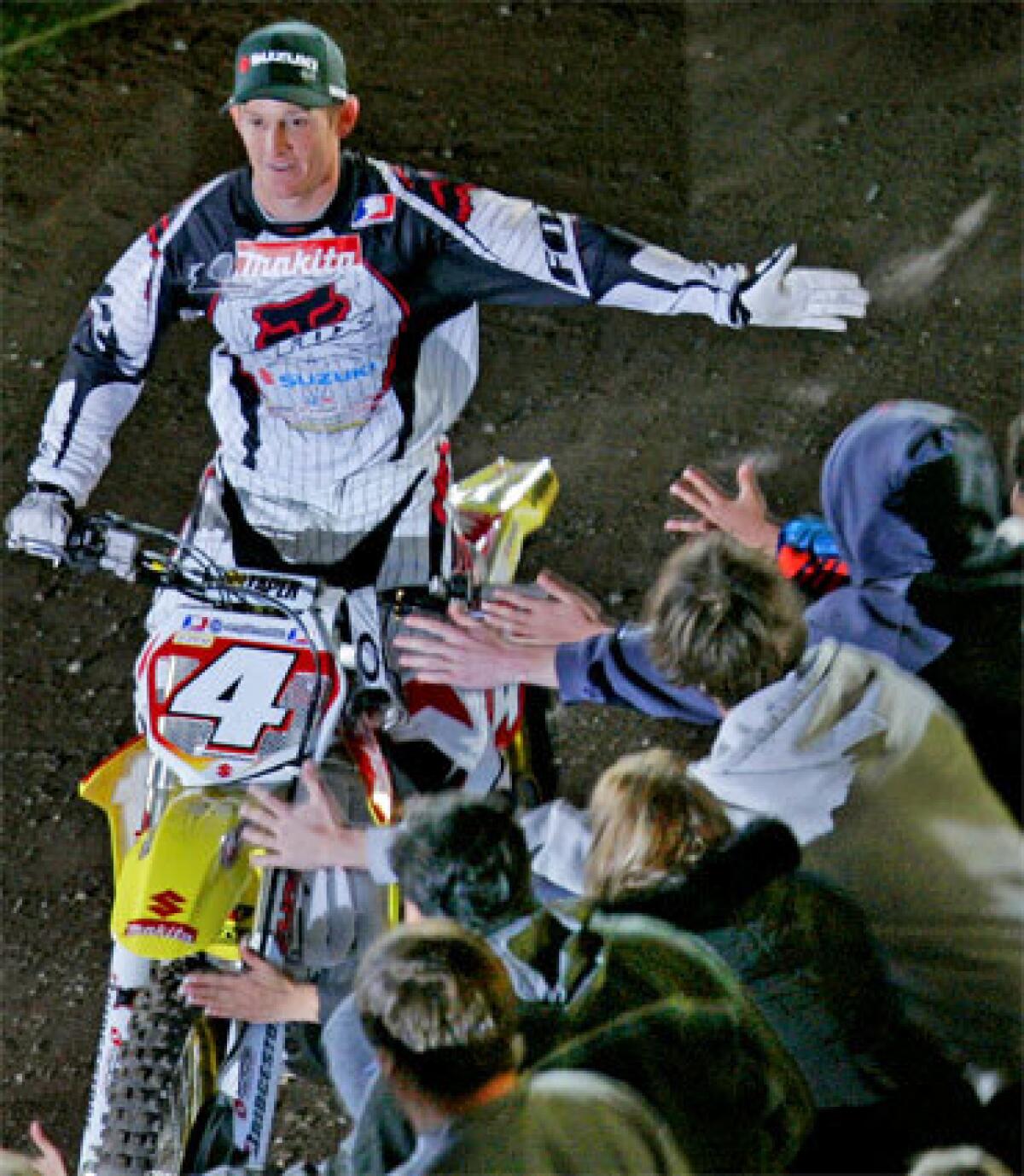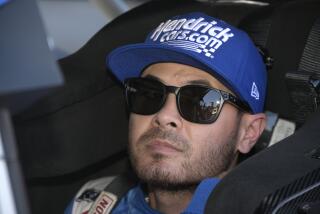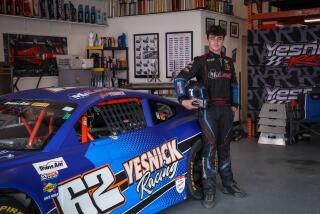Grandstand theater

TAKE 500 truckloads of dirt. Add a few dozen snorting motorcycles, a bunch of 70-foot jumps, some booming pyrotechnics and 45,000 screaming fans, and you’ve got one of the fastest-growing motorsports in the country in all its deafening, live glory.
Last weekend marked the beginning of the Amp’d Mobile AMA Supercross Series. It’s known simply as Anaheim 1 to those in the know, but for those who aren’t, it’s sort of like the Fourth of July, the Grammys and the Super Bowl all rolled into one.
In the summer, Anaheim’s Angel Stadium may belong to baseball, but in the winter it’s all about dirt, engines and wheels. Anaheim 1 was the first of three supercross races that alternate weekends through Feb. 3 with monster truck events (see story, Page 33). Each week, fans get a chance to interact with the sport’s top racers, industry reps and other fans before the main event, in pit parties that last for hours. And while it’s not exactly a night at the opera, it is a form of truly theatrical entertainment that appeals to a variety of income levels and professions -- not just off-roaders or, as non-fans might suspect, folks with a few missing teeth, but anyone with a taste for high-flying speed.
The roar of racers heading full throttle toward the first turn and the ensuing spectacle of candy-colored bikes crashing into the tough blocks as they jockey for position are a bit of an adrenaline rush, even if you don’t know that a “scrub” is a move in which racers pitch their bikes sideways off jumps, catch 30 feet of air and, seconds later, rotate their bikes from pancake flat to vertical on the landing.
“It’s very easy to watch. That’s why it’s catching on so fast,” said Ralph Sheehan, lead announcer for last weekend’s first live broadcast of Anaheim 1 on the cable channel Speed. “There’s guys flying through the air all over the floor doing things with motorcycles that defy logic, and they do it at incredible heights and speeds.”
Saturday night’s race was no exception as the sport’s superstars duked it out. On Lap 1, Chad Reed took the lead coming out of the first corner, with James Stewart and Ricky Carmichael nipping at his rear tire. By Lap 2, Stewart had claimed the top spot, followed by Reed and Carmichael. Lap 3, it was Stewart, Carmichael, Reed. Lap 4, Carmichael, Stewart, Reed. Then Carmichael crashed, giving Stewart an edge that would win him a first-place finish at the end of Lap 20. It was the sort of race that (almost) justified the $30-to-$70 ticket prices, $25 souvenir T-shirts and $4 Pepsis.
The Anaheim races are a big deal -- not because they count any more than the series’ other dates but because Southern California is the sport’s home turf. It’s where supercross, the in-stadium version of off-road motocross, was born 35 years ago and where its heart continues to beat strong. It’s where all the major bike manufacturers have set up U.S. headquarters, where most of the magazines are based, where the greatest concentration of off-roaders do their thing and where many top racers either live or train.
Throw in a rivalry among some of the most gifted supercrossers ever, riding the most powerful bikes made for the sport, on courses where they’re flying faster, farther and higher than anyone thought possible just two years ago, and you can see why Anaheim 1 was sold out and why tickets to Anaheim 2 and 3 are selling faster than ever before, according to event promoter and producer Live Nation.
Being so close to L.A., celebrities are also showing up at the events. Singer Michelle Branch, rapper Lil Jon and the first supercross superstar, Jeremy McGrath, were all sucking up exhaust fumes with the rest of the crowd Saturday. Previous years have also seen Travis Pastrana and other supercross superstars yukking it up on late-night TV with David Letterman and Jimmy Kimmel, and gracing the pages of men’s mags such as GQ and Sports Illustrated. Carmichael and Jeremy McGrath have each had their own video game deals. It’s only a matter of time before Stewart, or some other rising hotshot, starts getting the same treatment.
OFFICIALLY, Anaheim 1 didn’t start until 7 p.m. Saturday, but the parking lot was beginning to fill up around noon with the usual four-wheeled companions to avid two-wheelers -- pickup, RVs and trailers. The air was filled with the smell of tailgater barbecues and the sound of grunting four-strokes.
“We’ve been coming to races since I was little,” said 15-year-old Makenna Shultz, who was walking arm in arm through the crowd with Jessie Quinn. Like a lot of the fans at Anaheim, Shultz was there with her family, which has a motocross pedigree. Her dad used to race, and her boyfriend and cousin are both sponsored amateurs.
“I like watching it,” said Shultz, who is from Valencia. “It’s different than watching football because the whole level of difficulty’s a lot harder. It’s just more of an adrenaline rush, even watching it.”
Her favorite racer: “Chad Reed, because he’s really fast and he’s beautiful ... and, of course, Stewart,” she said, referring to the Kawasaki rider who’s favored to take over the sport after Carmichael, at age 27, retires this year and moves on to try his hand at NASCAR. “Gotta support Stewart,” she said, lifting a wrist to show a charm bracelet with a dangling, blinged-out No. 7 -- Stewart’s number.
Shultz was in an area known as the pit party, where fans pay $10 to go into an endless section of parking lot that’s temporarily transformed into a trade show pimping bikes, accessories, energy drinks and everything else related to the off-road lifestyle. From 12:30 to 5:30 p.m., it was shoulder to shoulder as fans shuffled their way down the stadium ramp and through the pit’s entrance, where a pair of young women wearing too much makeup and not enough clothes were handing plastic Progressive Insurance bags to everyone walking through. The bags were readily snatched up, soon to be stuffed with racing swag -- free magazines, trading cards, brochures, posters, autographs.
Megan Wisley didn’t have one of the bags; instead, the 31-year-old mom from Coalinga was wearing a backpack from Austrian off-road motorcycle manufacturer KTM that matched her son’s KTM jersey -- a jersey that was covered with dozens of black Sharpie signatures. Over the previous two hours, 7-year-old Dayton Wisley had collected about 30 autographs from pro racers who weren’t just competing at Anaheim 1 but also were taking the time to greet fans. It’s this racer accessibility that’s also helped the sport to grow.
“It’s so great for families, because you get to take these kids into these pit areas, let them meet the stars, then sit in the grandstands and say, ‘Wow. I met that guy and he was nice to me and he said my hat was cool.’ It makes a huge difference,” Sheehan said. “You can’t do that at the average football or baseball game these days, but in supercross they really work hard to make that a key part of the fan experience.”
Who are the kids at supercross events? Many of their parents are lifelong dirt bikers who are now incubating the sport with their kids, many of whom are now racing. In fact, 20 of these elementary school dirt devils were competing at Anaheim 1 as part of KTM’s Junior Supercross Challenge. Each year since 1997, the motorcycle manufacturer has given a handful of 7- and 8-year-old racers the opportunity to hold court with their own pit party autograph session and to compete on the same course as the pros during prime time, just moments after their heroes’ last qualifying heat.
The junior competition was pretty much the only time during the night that racers rolled, rather than flew over, the triple jumps. It was also the only portion of the program when the stadium buzzed with the high-pitch rev of two-strokes. Since the 2006 season, when the sport’s superstars traded their two-stroke 250s for the mightier four-stroke 450s, supercross has become a strictly four-stroke affair.
The sport hasn’t been the same since.
ON the Tuesday before Anaheim 1, Rich Winkler was repeatedly driving his bulldozer over the first lump of a triple to smooth it out, while a pair of beeping front-end loaders scooped away at the 6,000-cubic-yard master pile of dirt used to build the track.
“As a track designer, the four-strokes are making it tough,” said Rich Winkler, founder, owner and chief bulldozer operator for Dirt Wurx USA, which builds all the courses for the Amp’d Mobile Supercross series. “There’s things the four-strokes can do that the two-strokes couldn’t. The meaningless imperfections in the track when two-strokes were involved become real problems with the 450 four-strokes. We’ve had to rethink the tracks.”
Two-strokes are very, very light with almost instantaneous power delivery. On such a bike, pinpointing a landing in a rider-congested section of the track after a high-flying, long-distance jump was easier than it is on a four-stroke, which is a lot more powerful but also heavier and more difficult to land precisely.
“A little loose dirt or a little imperfection left from a bulldozer cleat on the back side of a jump used to be meaningless. Now, dressing out the back sides of things, stuff we didn’t use to pay a lot of attention to, has become a lot more important,” said Winkler, who was on the track before the main event Saturday, grooming away imperfections.
“The course has not evolved as quickly as the machines, and that’s not a fault of Rich Winkler or Dirt Wurx,” said Davey Coombs, editor of supercross magazine Racer X Illustrated. “I just think the bikes have gotten so good so quickly that the supercross theory is changing. It’s sort of a dynamic time for all of us.”
susan.carpenter@latimes.com
*
Riding to Anaheim
Supercross
When: Jan. 20 and Feb. 3: pit party, 12:30 to 5:30 p.m.; races start at 7 p.m.
Where: Angel Stadium, 2000 Gene Autry Way, Anaheim
Price: $30 to $70; $15 to $45 for ages 2 to 12; pit party, $10
Info: (714) 740-2000, www.supercrossonline.com
Monster Jam
When: Saturday and Jan. 27; pit party, 3 to 5 p.m.; races start at 7:30 p.m.
Price: $10 to $40; $10 for ages 2 to 12
Where: Angel Stadium, 2000 Gene Autry Way, Anaheim
Info: (714) 740-2000, www.monsterjamonline.com






